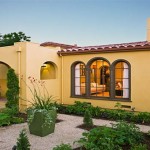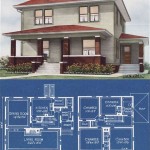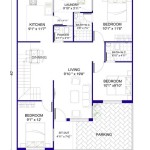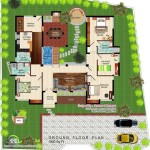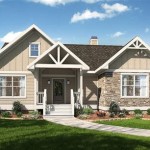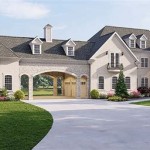Two Bedroom Tiny House Floor Plans: Maximizing Space and Comfort
The tiny house movement has gained significant traction in recent years, fueled by a desire for simplified living, reduced environmental impact, and financial freedom. Within the realm of tiny house design, the two-bedroom layout presents a unique challenge and opportunity: how to comfortably accommodate a small family, roommates, or provide dedicated guest space within a compact footprint. This article will explore various two-bedroom tiny house floor plans, examining key considerations for space optimization, functionality, and overall livability.
Designing a two-bedroom tiny house requires meticulous planning and a deep understanding of spatial relationships. Every square inch must be carefully considered and utilized to its fullest potential. The success of the design hinges on efficient use of vertical space, incorporation of multi-functional furniture, and a thoughtful approach to storage solutions.
Key Considerations for Two-Bedroom Tiny House Design
Before delving into specific floor plan examples, it is crucial to understand the fundamental principles that guide the design of a successful two-bedroom tiny house. These considerations encompass not only the layout itself but also the lifestyle of the occupants and the practical limitations of a small space.
Prioritizing Needs and Lifestyles: The design process should begin with a clear understanding of the occupants' needs and lifestyles. Who will be living in the house? What are their daily routines? What are their storage requirements? Understanding these factors will inform decisions about the size and layout of each room, the type of furniture needed, and the overall flow of the space. For example, a family with young children will have different needs than a retired couple or two roommates.
Optimizing Vertical Space: In a tiny house, maximizing vertical space is essential. This can be achieved through the use of lofts, bunk beds, and tall storage units. Lofts are particularly popular for bedrooms, as they free up valuable floor space for living areas. However, accessibility to the loft should also be factored in. Stairs or a ladder will be necessary, and the headroom in the loft should be sufficient for comfortable movement. Furthermore, consider the potential for installing a loft that is accessible solely by stairs, which can act as integrated storage units, increasing space efficiency.
Multi-functional Furniture and Storage Solutions: Furniture that serves multiple purposes is a cornerstone of tiny house design. A sofa bed can provide seating during the day and a sleeping space at night. A dining table that folds down when not in use can free up valuable floor space. Hidden storage compartments beneath beds and benches can provide ample space for clothing, linens, and other items. Built-in storage solutions, such as shelving units and drawers, are also highly effective in maximizing space utilization. Consider furniture that can be easily moved or reconfigured to adapt to different needs and activities.
Common Two-Bedroom Tiny House Floor Plan Arrangements
Several common floor plan arrangements are employed in two-bedroom tiny houses, each with its own advantages and disadvantages. The choice of layout will depend on the size and shape of the tiny house, as well as the specific needs and preferences of the occupants. Understanding the different configurations can assist in making an informed decision.
Dual Loft Layout: This is perhaps the most common layout for two-bedroom tiny houses. Two lofts are positioned at opposite ends of the house, typically above the living area and kitchen. This arrangement maximizes floor space by utilizing the vertical dimension. Access to the lofts is usually provided by ladders or stairs. The dual loft layout is particularly well-suited for families with children or for individuals who want separate sleeping spaces. However, it requires a significant amount of vertical space and may not be suitable for individuals with mobility issues.
Loft and Ground Floor Bedroom: This layout features one loft bedroom and one bedroom on the ground floor. The ground floor bedroom is typically located towards the rear of the house, providing a degree of privacy. The loft bedroom is usually positioned above the living area or kitchen. This arrangement offers a balance between vertical space utilization and accessibility. The ground floor bedroom is suitable for individuals with mobility issues or for those who prefer not to climb stairs or a ladder. The loft can then be used as a guest space or for children. This plan is amenable to aging in place, as one bedroom does not necessitate climbing.
Bunk Bed Configuration: This layout utilizes bunk beds to create two sleeping spaces within a smaller footprint. Bunk beds are typically positioned along one wall of the house, freeing up floor space for other activities. This arrangement is particularly well-suited for children or for individuals who are comfortable sharing a room. However, bunk beds can feel cramped and may not be suitable for adults or individuals who require more personal space.
Combination Layouts: It is also possible to combine elements of different layouts to create a custom floor plan that meets specific needs. For example, one could have a loft bedroom above a living area, and a ground-floor bedroom with a built-in bunk bed. This approach allows for greater flexibility and can optimize space utilization based on the specific requirements of the occupants.
Specific Design Considerations for Each Room
In addition to the overall floor plan arrangement, specific design considerations should be given to each room within the tiny house. This includes the living area, kitchen, bathroom, and, of course, the two bedrooms.
Living Area: The living area should be designed to be comfortable and inviting, despite its small size. Multi-functional furniture, such as a sofa bed or a convertible coffee table, is essential for maximizing space. Ample natural light can make the space feel larger and more open. Consider incorporating features such as a built-in entertainment center or a small fireplace to enhance the functionality and ambiance of the living area. Adequate space for circulation is also a key factor.
Kitchen: The kitchen should be functional and efficient, with adequate space for food preparation and storage. Compact appliances, such as a smaller refrigerator and a two-burner cooktop, can save space. Vertical storage solutions, such as shelves and hanging racks, can maximize storage capacity. Consider incorporating a fold-down countertop or a movable island to provide additional workspace when needed. Efficient placement of appliances can optimize workflow within the kitchen.
Bathroom: The bathroom in a tiny house is typically very small, so careful planning is essential. A composting toilet or a low-flow toilet can conserve water. A shower stall instead of a bathtub can save space. A wall-mounted sink can free up floor space. Consider incorporating a medicine cabinet and other storage solutions to maximize storage capacity. Adequate ventilation is crucial to prevent moisture buildup. Efficient use of light and mirrors can make the space feel larger.
Bedrooms: The bedrooms should be designed to be comfortable and private, even in a small space. In loft bedrooms, adequate headroom is essential. Consider incorporating windows for natural light and ventilation. Built-in storage solutions, such as shelves and drawers, can maximize storage capacity. In ground floor bedrooms, consider incorporating a door or partition to provide privacy. The use of calming colors and textures can create a relaxing atmosphere.
Accessibility and Egress: Ensuring safe and easy access and egress is paramount. This is especially relevant when lofts are used for bedrooms. Stairs are generally safer and more comfortable than ladders, particularly for older adults or individuals with mobility limitations. However, stairs require more floor space. Ladders should be sturdy and well-secured. Emergency escape routes should be clearly defined and easily accessible. Local building codes should be consulted to ensure compliance with safety regulations.
Lighting and Ventilation: Proper lighting and ventilation are crucial for creating a comfortable and healthy living environment in a tiny house. Ample natural light can make the space feel larger and more open. Strategically placed windows can provide cross-ventilation, reducing the need for air conditioning. Consider incorporating skylights to bring in additional natural light. LED lighting is energy-efficient and produces less heat. Exhaust fans should be installed in the bathroom and kitchen to remove moisture and odors. Well-planned lighting can significantly enhance the livability of a small space.
Material Selection and Construction: The choice of materials and construction methods can significantly impact the cost, weight, and durability of a tiny house. Lightweight materials, such as cedar siding and aluminum roofing, can reduce the overall weight of the house, making it easier to tow. Sustainable materials, such as reclaimed wood and bamboo flooring, can reduce the environmental impact. Proper insulation is essential for maintaining a comfortable temperature and reducing energy consumption. The tiny house should be built to withstand the elements and meet all applicable building codes. Professionals should handle any electrical or plumbing work.
Designing a two-bedroom tiny house is a complex but rewarding endeavor. By carefully considering the needs of the occupants, optimizing vertical space, incorporating multi-functional furniture, and paying attention to detail in each room, it is possible to create a comfortable, functional, and stylish living space within a compact footprint. The floor plans and design considerations detailed above provide a starting point for creating a personalized tiny house that reflects individual lifestyles and preferences.

The Best 2 Bedroom Tiny House Plans Houseplans Blog Com

2 Bedroom Tiny House Plans Blog Eplans Com

The Best 2 Bedroom Tiny House Plans Houseplans Blog Com

2 Bedroom Tiny House Plans Blog Eplans Com

2 Bedroom Tiny House Floor Plan

Tiny House Plans For Families The Life Floor Cabin

The Best 2 Bedroom Tiny House Plans Houseplans Blog Com

2 Bed Tiny Home Plan 21277dr Architectural Designs House Plans

2 Bedroom Tiny House Plans Blog Eplans Com

Gorgeous Two Bedroom Tiny House Designs To Inspire The Life

